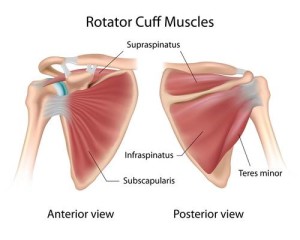How Your Rotator Cuff Muscles Work
How Your Rotator Cuff Muscles Work
Struggling with shoulder pain? Have a hard time working out or moving around because of it? In this case, you might have a rotator cuff injury. The rotator cuff muscles protect your shoulder joints and make smooth shoulder rotation possible. Even the slightest injury can affect your range of motion and cause severe pain.
Fortunately, you can prevent and relieve these symptoms with physiotherapy. A physical therapy specialist can recommend you rotator cuff exercises that stabilize and strengthen these muscles and lower injury risk. First, let's see how your rotator muscles function and why they are so important:
Rotator Cuff Muscles at a Glance 
The rotator cuff consists of four muscles that stabilize your shoulder. These include:
- Infraspinatus
- Supraspinatus
- Subscapularis
- Teres minor
Rotator cuff muscles assist with shoulder elevation and rotation. This means they allow you to move your arm over your head and away from the body. Moreover, the rotator cuff helps keep your arm well centered in its socket while the more powerful mover muscles push, press, and lift.
Rotator Cuff Injuries to Be Aware of
Just like any other muscle, the rotator cuffs are prone to injury. Rotator cuff tears, calcific tendonitis, shoulder bursitis, and rotator cuff impingement can affect people of ages. These problems are often the result of poor lifting form, chronic tears, repetitive trauma to the muscle, overtraining, or bone spurs around the shoulder.
Rotator cuff injuries typically cause a dull ache, limited range of motion, and arm weakness. You may have a hard time reaching behind your back or combing your hair. Lying on the affected shoulder can make pain worse.
Best Rotator Cuff Exercises
A physical therapist (physio) can prescribe rotator cuff exercises that help prevent injury and speed up healing. For instance, mobility exercises, such as the pendulum, increase space in the shoulder joint and help ease pain.
Once you able to move your shoulders, you can try stretching exercises. Their role is to boost shoulder flexibility and range of motion. Some examples include overhead stretches, up-to-back stretches, wall walks, or posterior capsule stretching.
Later, you can perform isometric and eventually dynamic rotator cuff exercises that increase muscle strength and boost performance. Lateral rotations, internal rotations, and external rotations are a safe choice, and as you advance and strengthen your rotator cuff, your physio will introduce fun and dynamic exercises. You should not feel pain during exercise and isolated weakness should resolve with the correct physical therapy program. Take the time to warm up before getting started, healing takes time and intention.
Take Home Tip: Even if you don’t have an injury, you can still benefit from rotator cuff exercises. These basic movements help keep your shoulder joint stable, restore range of motion, and may even prevent further injuries!
Posted In:
Shoulder Physical Therapy
Athletes Physical Therapy
